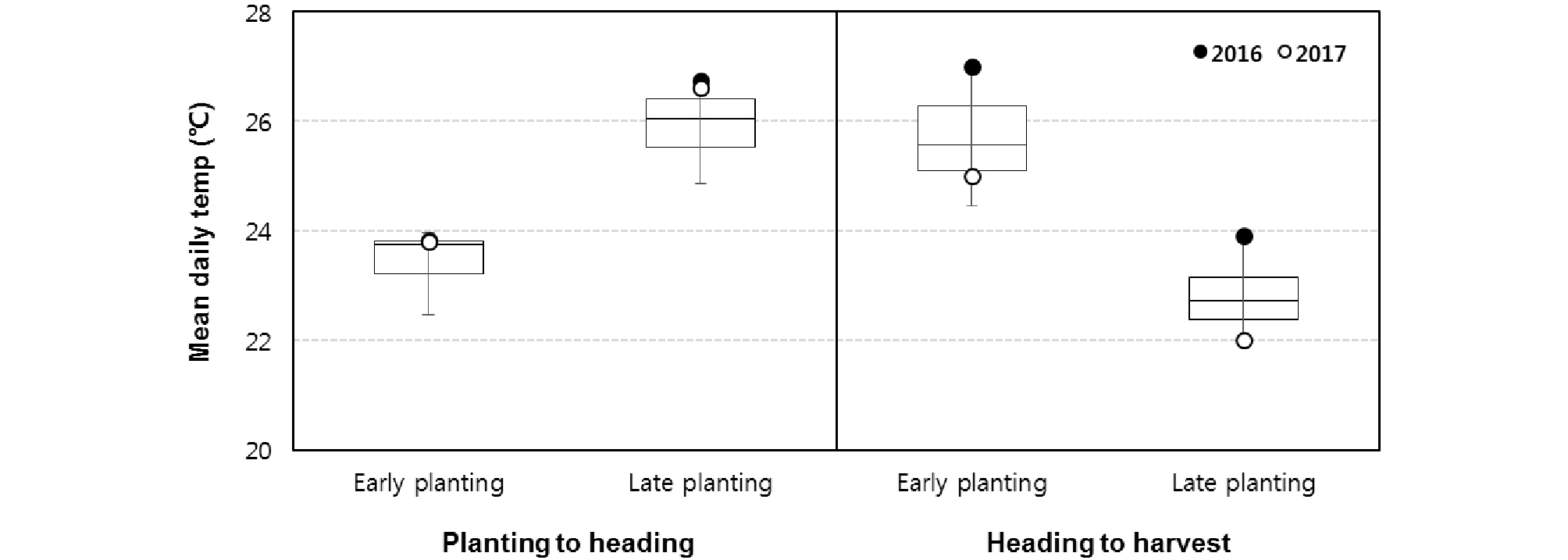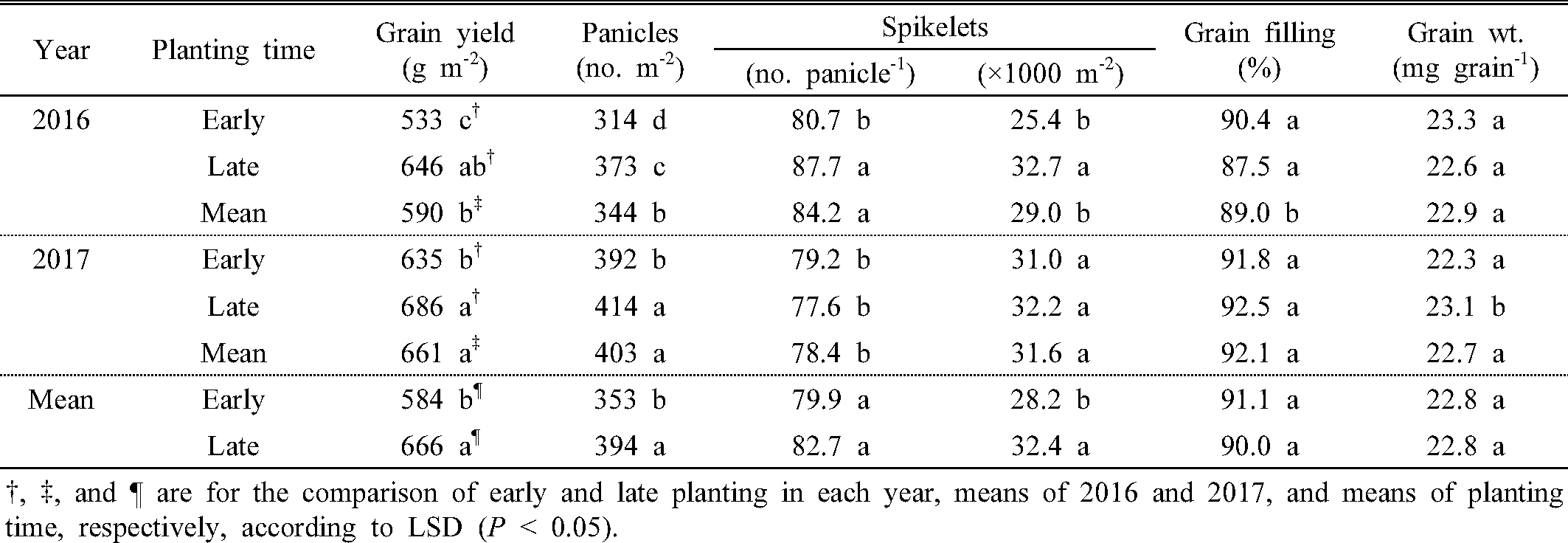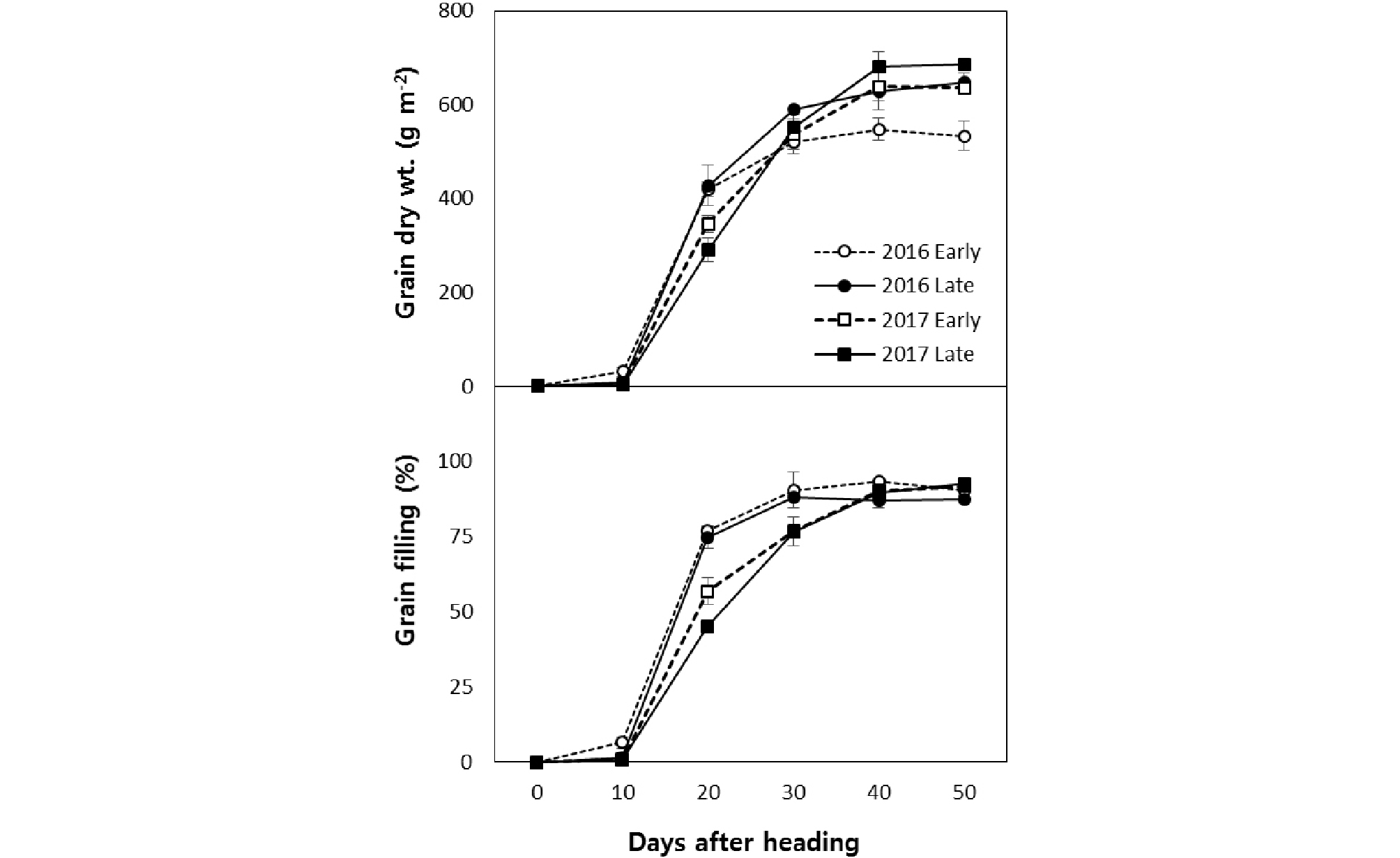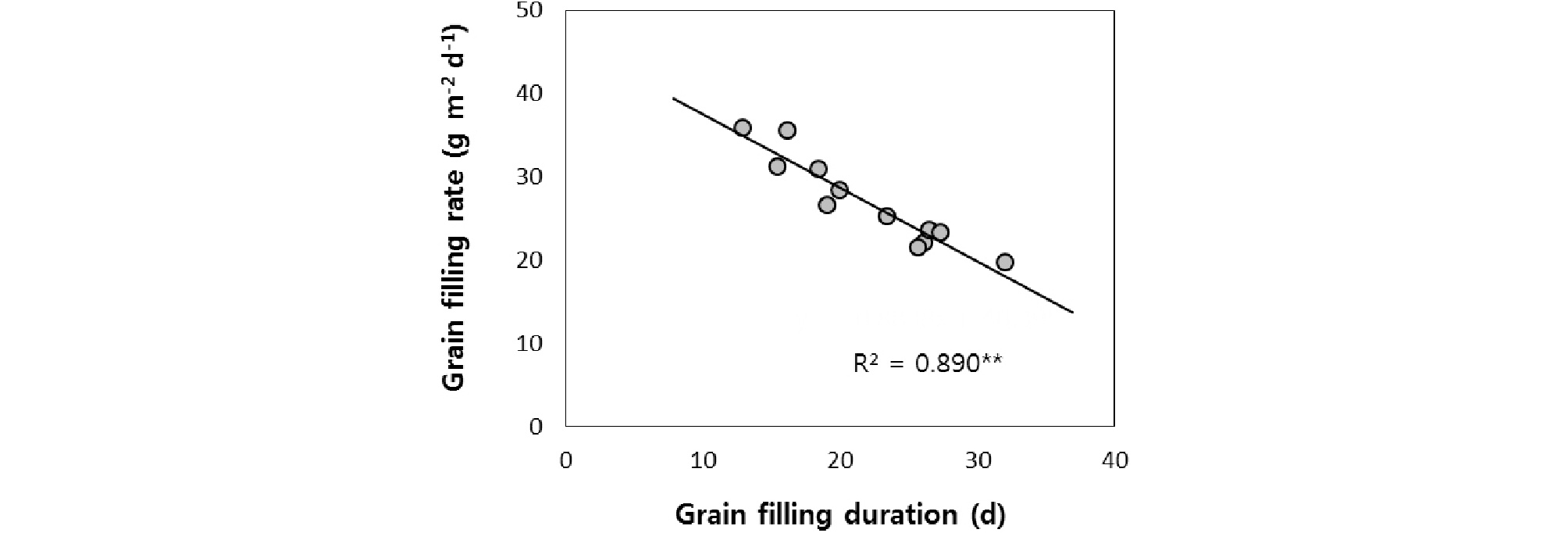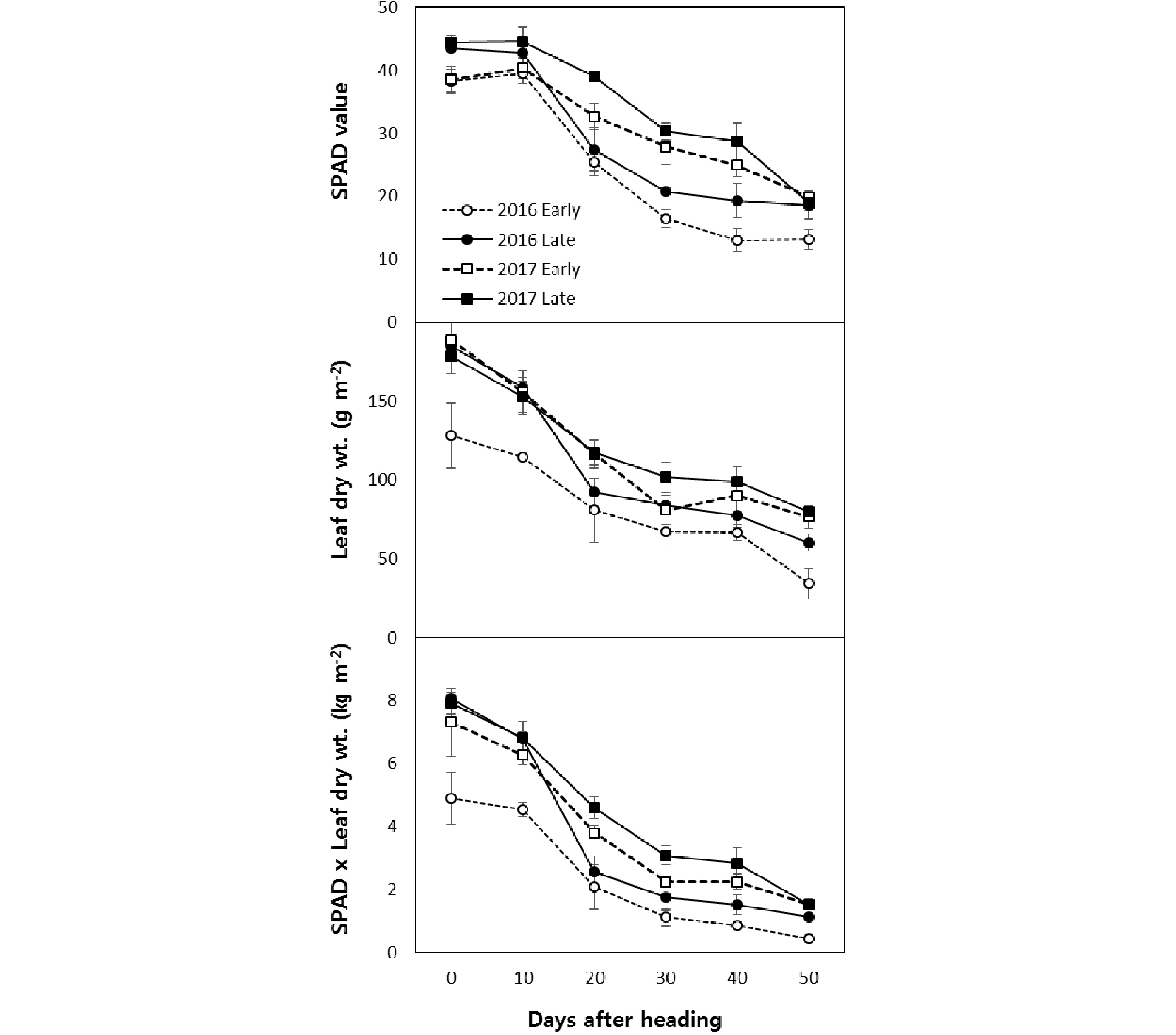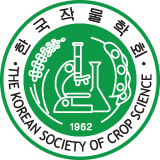INTRODUCTION
MATERIALS AND METHODS
Experimental site, plant material and treatments
Crop management
Weather data collection, plant sampling and measurements
Data analysis
RESULTS
Climatic conditions
Grain yield and yield attributes
Grain filling process
Leaf activity during grain filling period
DISCUSSION
CONCLUSION
INTRODUCTION
Determination of crop season in temperate area is critical to yield performance of rice due to much greater variation of temperature in a year than tropical regions. An example was reported that the amplitude of mean temperature in a year reached 30℃ in a temperate region while it was only 5℃ in a tropical region (Yang et al., 2007b), indicating that crops could be subjected to a wide variation of environment according to cropping season in temperate area. Therefore, determination of cropping season is an important management practice for temperate environments.
Cock & Yoshida (1972) reported that photosynthetic activity during grain filling stage had a much greater effect on carbohydrate accumulation in rice grains than translocation of assimilates stored in plants at flowering stage. Similar result was reported in comparison of climatic environments contributing to rice grain yield before and after flowering (Yang et al., 2008a). During grain filling of japonica rice, optimum temperature for high grain yield and quality has been reported in the environment-controlled studies (Yoshida & Hara, 1977; Kim, 1983) and also in the field trials (Choi et al., 2011; Yang et al., 2015). Some studies have investigated the effects of solar radiation on rice gain yield and quality (Dobermann et al., 2000; Evans & De Datta, 1979; Islam & Morison, 1992; Xing et al., 2017; Yang et al., 2015; Yoshida & Hara, 1977).
After flowering, grain growth of rice shows a sigmoid curve undergoing three phases: lag phase, linear increasing phase, and late filling phase (Cho et al., 1988; Yoshida, 1981). Among these, linear increasing phase, called effective grain filling period, is regarded more important than the duration of ripening from heading to harvest (Yoshida, 1981). In rice, the rate and duration of grain filling affect final grain weight and density (Jongkaewwattana & Geng, 2001). When investigated on a single panicle basis, high-yielding genotypes of rice were attributed to rapid grain filling rate, not long grain filling duration (Cho et al., 1987; Jones et al., 1979). However, when tested on a single grain basis, co-contribution of duration and rate of grain filling to grain size was observed (Fujita et al., 1984) while inferior grains on a panicle were associated with shorter grain filling duration (Cho et al., 1988). When tested on area basis, high yielding cultivars demonstrated long grain filling duration in both japonica rice (Yang et al., 2007a) and indica rice (Yang et al., 2008b). It has not been clarified yet why grain yield in rice showed such different responses when tested on a panicle or single grain basis and on area basis. However, area-based analysis would have more direct impact in relation to grain yield since productivity is based on land area and a panicle or a grain is one of the elements that comprise productivity.
The above-mentioned studies focused on genotypic ability of rice in relation to the comparative contribution of duration and rate of grain filling to grain yield. Several studies explored the effects of environments such as temperature and radiation on the duration and rate of grain filling. In some studies, high temperature shortened grain filling duration and accelerated grain filling rate of rice (Ahmed et al., 2015; Fujita et al., 1984; Yoshida & Hara, 1977). In other studies, however, high temperature during grain filling period did not affect grain filling duration (Lee et al., 2015) and it did not reduce potential grain dry matter increase rate (Kobata & Uemuki, 2004). While low radiation resulted in the reduction in grain filling percentage and consequent yield loss, it caused only a slight delay in grain filling of a whole panicle of rice (Yoshida & Hara, 1977).
There has been an argument whether source activity, represented by photosynthesis and related parameters such as nitrogen concentration, chlorophyll content, and mass of leaves (Park & Lee, 2003a), is limiting rice grain yield. Park & Lee (2003b) compared leaf senescence of different rice genotypes and reported that delayed senescence of upper leaves and rapid senescence of lower leaves were positively associated with grain yield. Wei et al. (2018) observed that rice genotypes with early senescence and poor source/sink ratio had relatively high grain nitrogen concentration, which was related to low grain yield. This finding indicates that high-yielding rice genotypes have low nitrogen concentration in grains, hence late senescence or high source/sink ratio is required to breed high-yielding rice varieties. Meanwhile, Kim et al. (2011) suggested that earlier termination of grain filling under high temperature was resulted from loss of sink activity, not from earlier leaf senescence. Contrary findings in the studies by Kim et al. (2011) and Wei et al. (2018) may indicate that effect of source activity on grain yield of rice is different depending whether their variations come from genotypes or environments.
Although there are accumulated information on the relationships among grain filling rate, grain filling duration and grain yield, most investigations have been made to account for genotypic variations. In addition, source activities in relation to senescence have been studied mainly focusing on the approach to determine whether they are limiting grain filling and yield of rice. This study was performed with aims to clarify (1) if environmental variation of grain filling duration has a positive relationship with grain yield, (2) whether loss of leaf activity during grain filling contributes to grain yield, and (3) if grain filling duration and loss of leaf activity during grain filling stage are interlinked in a given genetic background of temperate rice.
MATERIALS AND METHODS
Experimental site, plant material and treatments
Field experiments were conducted at the research farm of the National Institute of Crop Science, Suwon, Republic of Korea (37°27′N, 126°99′E, 34-m elevation) in 2016 and 2017. A temperate japonica rice cultivar with short growth duration, ‘Baegilmi’, was selected as a plant material to widen climatic variations in the range of appropriate growth period of rice in Korea. This cultivar was transplanted on May 26 for early planting and on June 25 for late planting to induce wide variations of temperature and radiation during grain filling period of rice. Mean daily temperature from planting through heading of 2016 and 2017 were among the highest in the last 10 years (Fig. 1). From heading to harvest, year 2016 had the highest temperature while year 2017 showed the lowest temperature level during the past 10 years in both early and late planting. It was estimated that plant materials in this study were subjected to considerable climatic variations by controlling planting times and experimental years.
Plots, with planting date as a treatment, were laid out in a randomized block configuration with three replicates at the same fields for two years. The soil was a Fluvaquentic Endoaquetps with pH 5.1, 18.2 g organic C kg-1, and 7.7 cmol kg-1 cation exchange capacity to 30 cm depth.
Crop management
Seeds submerged in tap water were dried at room temperature, then 130 g of seeds were packed in each gauge zipper bag. The bags were submerged for 48 hours in a 30℃ solution diluted from 8%-ipconazole by 1/500 with water. Then the seeds were soaked in water at 30℃ for following 24 hours. The pre-germinated seeds in a bag were sown in seedling trays then kept at 30℃ for 48 hours until seedling emergence. To prevent the damage of emerged seedlings from high irradiance, trays were kept under the shadow for 24 hours before settling them on seedbeds.
Crop management followed the standard cultural practices for rice in Korea. Thirty-day old seedlings were machine- transplanted at a hill spacing of 0.3 × 0.14 m with 3-5 seedlings per hill for each transplanting date. Fertilizers were manually broadcasted and incorporation into paddy soil was made only for basal application. Ninety kg N ha-1 was split-applied by 50% at basal, 20% at tillering initiation, and 30% at panicle initiation stage. Forty-five kg P ha-1 was applied as a basal fertilizer immediately before puddling the fields. Fifty-seven kg K ha-1 was split-applied: 70% at basal and 30% at panicle initiation. The experimental fields were flooded at 1-3 cm depth for 7 days from transplanting. Then 5-10 cm water depth was maintained until 40 days after heading (DAH) when the fields were permanently drained, except for 5-7 days at mid-tillering stage of rice for intermediate field drainage.
Weeds and pests were controlled by chemicals to avoid biomass and yield loss. Mixture of benzobicyclon at 0.125 L of active ingredient (a.i.) and thiobencarb at 1.5 L of a.i. ha-1 was applied at one day after puddling fields to control germinating weeds. Additionally, mixture of bromobutide at 0.75 L, imazosulfuron at 0.075 L, and mefenacet at 1 L of a.i. ha-1 was applied at 12-15 days after transplanting to control young weeds. Carbofuran at 1 kg and isoprothiolane at 4.8 kg of a.i. ha-1 were applied at basal to control insects and diseases. Cnaphalocrocis medinalis (rice leaf folder) was controlled by spraying etofenprox at 0.16 L of a.i. h-1 during grain filling stage of rice.
Weather data collection, plant sampling and measurements
Daily mean temperature and solar radiation, collected from the Suwon Meteorological Bureau located about 500 m apart from the experimental fields, were used to calculate temperature and solar radiation during effective grain filling periods.
Plant samplings were made 6 times at 10-day interval from heading to 50 DAH to measure the traits related to grain filling and leaf activity. For each time, after sampling 20 hills (0.84 m2) for each replicate, number of panicles for each hill was counted and averaged. Then, five hills showing average number of panicles from the 20 hills were selected for further measurements. Chlorophyll meter readings were made at upper, middle, and lower parts on the flag leaf of a main culm for each of the selected five hills, using SPAD-502 (Soil Plant Analysis Dev. (SPAD) Section, Minolta Camera Co., Osaka, Japan). The average SPAD value from the five hills was used as a replicate. After removing roots, the five hills for each replicate were combined and separated into leaves, culm + leaf sheath, and panicles. Panicles were manually threshed into rachis and spikelets. Then filled spikelets were separated from unfilled spikelets by submerging them in tap water. Filled spikelets and unfilled spikelets were counted to calculate spikelet number per panicle, grain filling percentage, and individual grain weight. Filled spikelets and leaves were oven-dried at 70℃ to constant weight to determine dry weight.
Data analysis
Grain yield and yield attributes were analyzed following analysis of variance with experimental years and planting times as independent variables, using SPSS statistical software. Time-series data for the grain dry weight were used to analyze duration and rate of grain filling. Grain filling process for each replicate was fitted by Richards (1959) growth equation to calculate duration and rate of grain filling as a function of day degree after flowering, using SPSS statistical software:
 (1)
(1)
where W is the grain weight (g m-2), A the final grain weight, t days after heading, and B, k and N are coefficients determined by the non-linear regression equation (1). Grain filling duration was taken from the DAH when W was 5 % (t1) to the DAH when W was 95 % (t2) of A. The grain filling rate was calculated by dividing the grain mass accumulated from t1 to t2 by number of days during the period. Similarly, grain filling process was fitted by substituting cumulative air temperature (CT) and cumulative solar radiation (CR) from heading for t in equation (1) to calculate CT and CR required to attain W from 5% to 95% of A. The parameter, SPAD value × leaf dry weight, was used to combine the effects of leaf activity in a given point on a leaf blade and total leaf mass. Simple correlation analyses were undertaken to investigate relationships among the traits associated with grain filling and leaf activity.
RESULTS
Climatic conditions
From planting to heading, mean daily temperature was similar in 2016 and 2017 but was higher in late planting than early planting (Fig. 2). From heading to harvest, mean daily temperature was higher in 2016 than 2017 and in early planting than late planting. Mean daily solar radiation did not show a consistent trend according to experimental years and planting times. For each planting time, temperature demonstrated a relatively small yearly variation before heading but a large yearly variation during grain filling stage. For each year, late- planted rice were subjected to higher temperature before heading but lower temperature after heading than early-planted rice. Among the four treatments, late-planted rice in 2016 and early-planted rice in 2017 were subjected to similar temperature and radiation during grain filling stage.
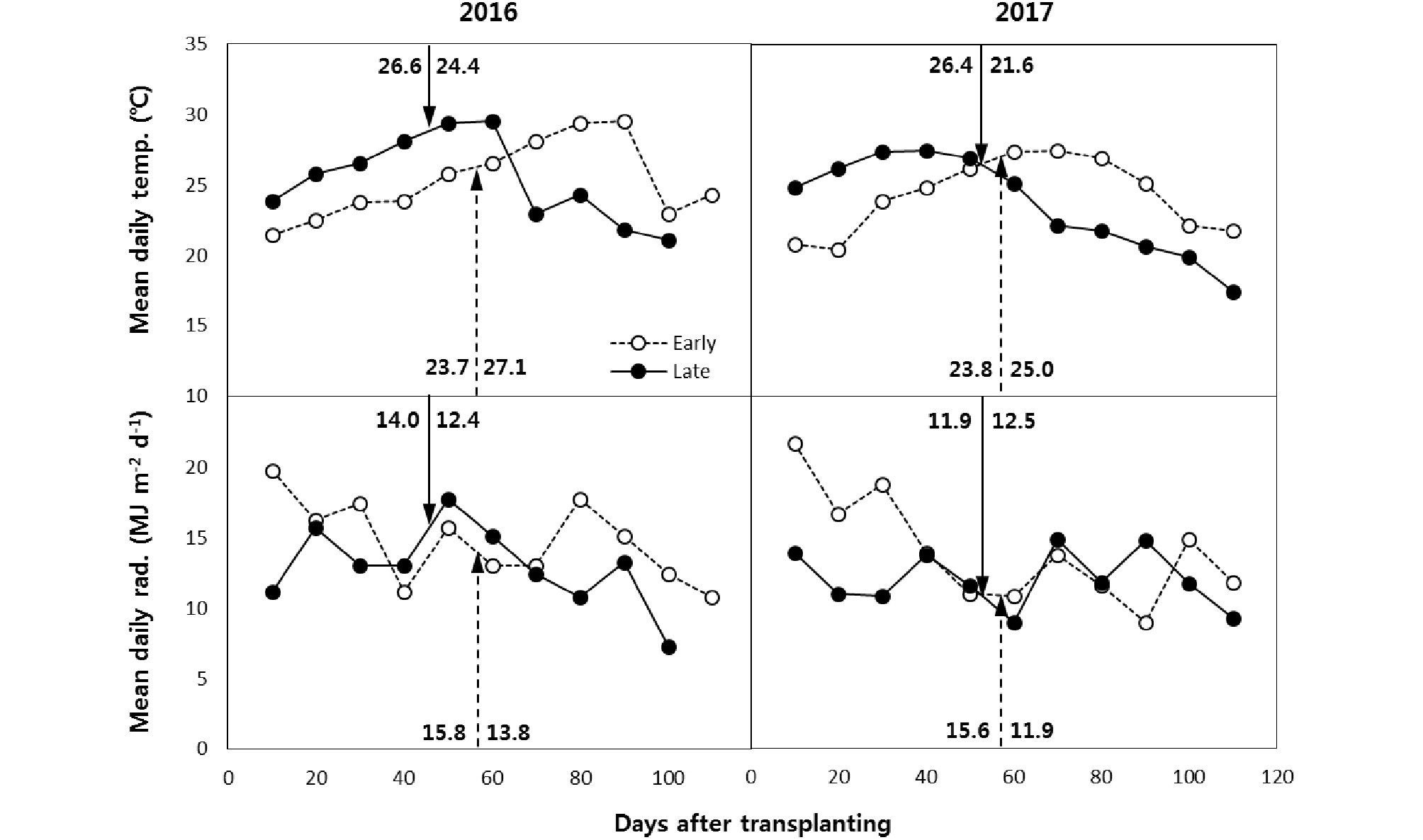
Fig. 2.
Changes in mean daily temperature and mean daily solar radiation during the growth period of temperate japonica rice ‘Baegilmi’ at early and late planting in 2016 and 2017. Dashed and solid arrows indicate heading dates at early planting and late planting, respectively. In each panel, temperatures and solar radiation levels from transplanting to heading and from heading to harvest are presented on the left and right of the arrows, respectively.
Grain yield and yield attributes
Grain yield was higher in late-planted rice than early-planted rice in both years and the difference was more in 2016 than 2017 (Table 1). Higher grain yield was achieved in 2017 at both planting dates. Early-planted rice in 2016 and late-planted rice in 2017 produced the lowest and the highest grain yield, respectively. Difference in grain yield was fairly small between late planting in 2016 and early planting in 2017. The number of panicles per square meter was significantly greater in 2017 than 2016 and at late planting than early planting. The number of spikelets per panicle was significantly different depending on experimental years but not on planting times. Significantly greater sink size (spikelets m-2) was achieved in late planting than early planting and in 2017 than 2016. Grain filling percentage was significantly different depending only on experimental years but not on planting times. Experimental years and planting times did not show any significant differences in individual grain weight.
Grain filling process
Rice grains were filled mostly from 10 to 40 DAH in all treatments (Fig. 3). Increase in grain filling percentage and grain dry weight from 10 to 20 DAH was lower but that from 30 to 40 DAH was higher in 2017 than 2016. In 2016, grain filling percentage was not different between early and late planting throughout the ripening period. Late-planted rice demonstrated grain dry weight similar to early-planted rice until 20 DAH but higher than early-planted rice after 30 DAH in 2016. In 2017, grain filling percentage and grain dry weight at 20 DAH were higher in early planting than late planting. After 40 DAH, late-planted rice showed the grain filling percentage similar to early-planted rice but the grain dry weight higher than early-planted rice.
When plotted to determine the contribution of duration and rate of grain filling to grain yield, final grain weight per unit area was correlated positively with grain filling duration but negatively with grain filling rate (Fig. 4). Grain filling duration was negatively associated with grain filling rate (Fig. 5).

Fig. 4.
Association of final grain weight with the grain filling duration and the grain filling rate for an effective grain filling period, fitted to Richards’ non-linear regression equation. Data were pooled across experimental years and planting time points. Each data point is a replicate (n = 12); ** significant at p = 0.01, * significant at P < 0.05.
Grain filling duration was highly significantly correlated with cumulative temperature and cumulative radiation for effective grain filling period in a positive manner (Fig. 6). Meanwhile grain filling rate was associated negatively with cumulative temperature and cumulative radiation for effective filling period.
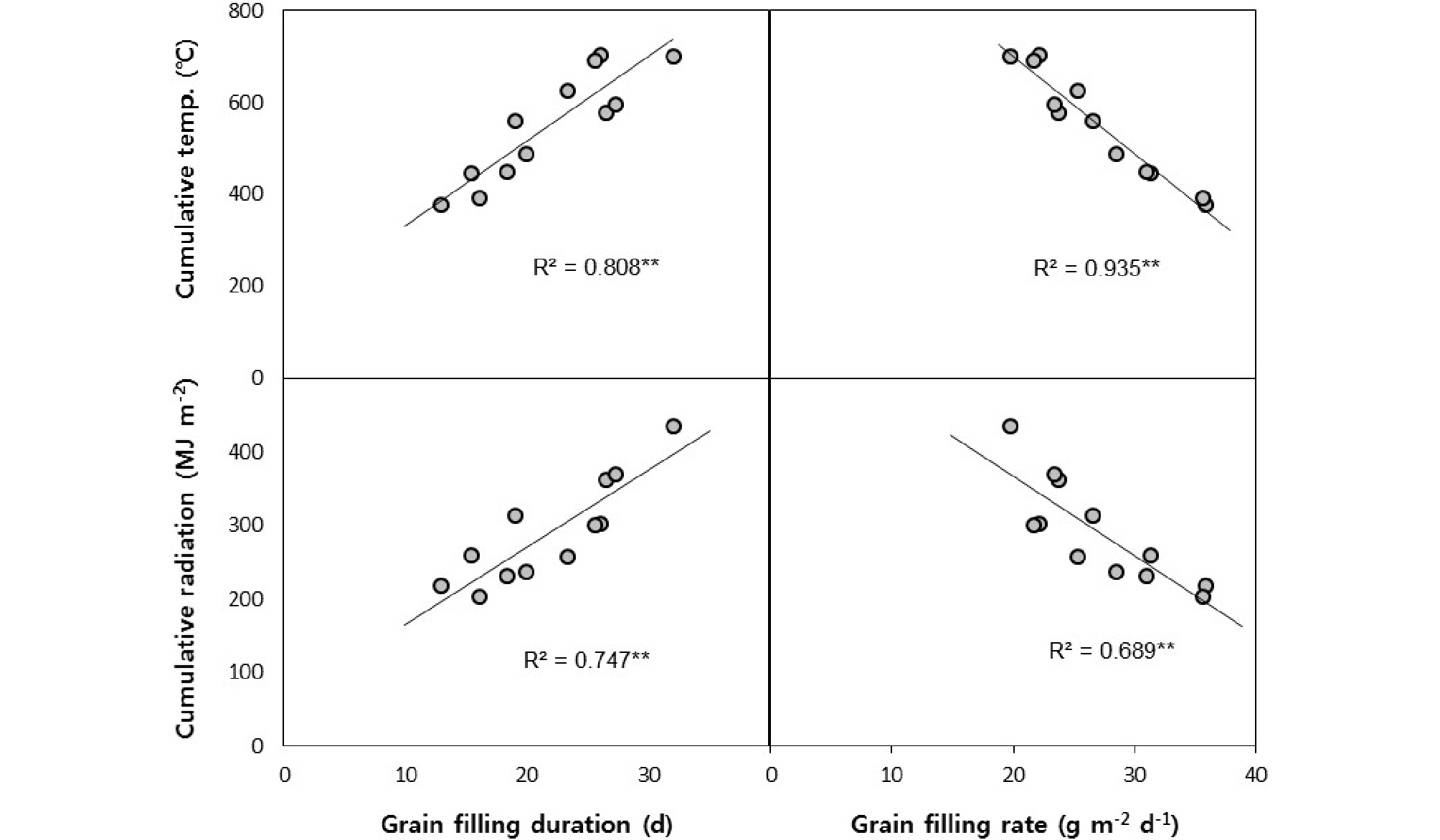
Fig. 6.
The relation of the grain filling duration and the grain filling rate with cumulative temperature and cumulative radiation for an effective grain filling period, fitted to non-linear regression equations. Data were pooled across experimental years and planting time points. Each data point is a replicate (n = 12); ** significant at p < 0.01.
Leaf activity during grain filling period
SPAD values in 2017 were similar to 2016 at 0-10 DAH and were higher than 2016 at 20-40 DAH for both early and late planting (Fig. 7). But at 50 DAH, SPAD values in 2017 were higher than 2016 for early planting and similar to 2016 for late planting. Late-planted rice demonstrated consistently higher SPAD values than early-planted rice throughout grain filling stage in both years, except 50 DAH in 2017. Leaf dry weight was maintained higher in 2017 than 2016 for both planting times, except at 0-10 DAH for late planting. Late-planted rice exhibited consistently higher leaf dry weight than early-planted rice throughout grain filling stage in 2016. Meanwhile, late-planted rice demonstrated similar leaf dry weight to early-planted rice at most stages during grain filling in 2017. Except 0-10 DAH for late planting, SPAD value × leaf dry weight was maintained higher in 2017 than 2016 for both early and late planting. Late-planted rice demonstrated consistently higher SPAD value × leaf dry weight during grain filling stage than early-planted rice in both years, except 50 DAH in 2017.
Grain dry weight at final harvest had correlations neither with decreased SPAD values nor with decreased leaf dry weight for 50 DAH (Fig. 8). But the reduction of SPAD value × leaf dry weight for the same period was highly significantly correlated with grain dry weight at 50 DAH in a positive manner. When plotted with the data pooled across experimental years and planting times, grain filling duration did not show significant correlations with any of the decreases in SPAD values, leaf dry weight, and SPAD value × leaf dry weight for 50 DAH.
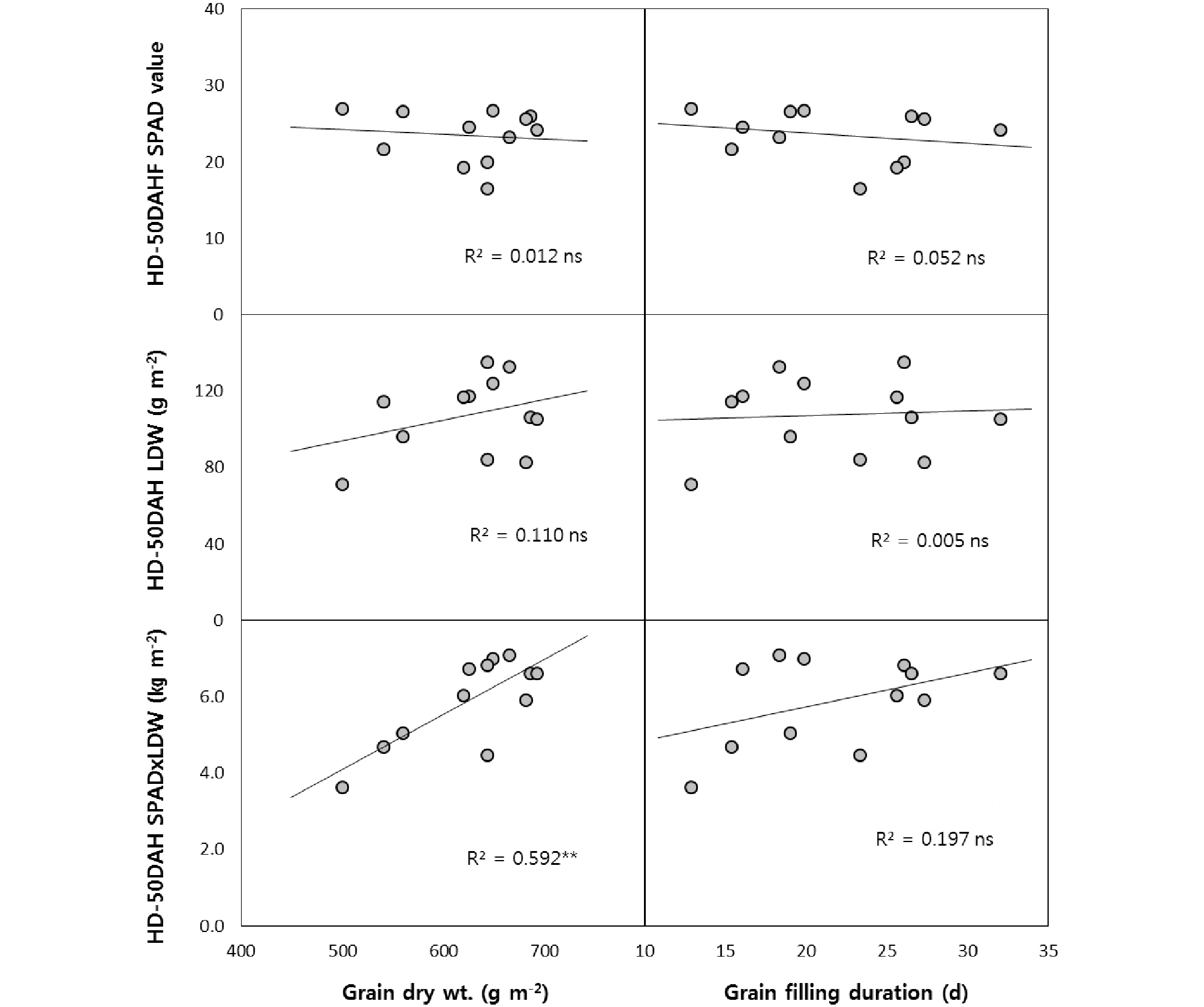
Fig. 8.
Association of grain dry weight at harvest and grain filling duration with the reductions in SPAD value, leaf dry weight, and SPAD value × leaf dry weight from heading to 50 days after heading. Data were pooled across experimental years and planting time points. Each data point is a replicate (n = 12). HD; heading, DAH; days after heading, LDW; leaf dry weight, ** significant at p < 0.01, ns: not significant.
DISCUSSION
In a temperate country, Korea, gap of mean temperature in a year reaches about 30℃ (Yang et al., 2007b). This large temperature gap, unlike in the tropical conditions where temperature is relatively stable throughout a year, plays a critical role in determining optimal cropping seasons for environmental adaptation in rice. In the present study, when different environments were imposed on a temperate rice cultivar during grain filling, higher grain yields were achieved under the late planting compared to early planting (Table 1). Sink size determined until heading stage of rice should be supplied with sufficient assimilates during grain filling stage to be reflected to high grain yield. Therefore, securing sink size could be a prerequisite for high yielding and grain filling process acts as a direct contributor to yield performance.
When a temperate rice was subjected to varying environments, grain filling process demonstrated different patterns. High grain yield in late planting accompanied relatively less increase in grain weight at early filling stage but more gain in grain weight at late filling stage (Table 1, Fig. 3). This trend was the same when compared experimental years, showing more assimilate accumulation at late grain filling stage in 2017 than 2016. Higher grain yield accompanied by more assimilate accumulation in rice grains at late filling stage prompted to an assumption that longer grain filling duration was associated with higher grain yield. Indeed, final grain weight increased with extended grain filling duration (Fig. 4). This result is similar to previous reports on the relationship between grain filling duration and grain yield on area basis in japonica rice (Yang et al., 2007a) and indica rice (Yang et al., 2008b). Those previous studies examined the relationships induced by genotypic variations. However, variations of grain filling duration and grain filling rate in present study were brought by environmental effects because one single cultivar was used and the same cultural methods were applied to this study. Therefore, as combining the findings in the previous studies and the results in present study, grain filling duration may be a genetically and environmentally common contributor to high grain yield in temperate rice. Similar to previous findings in genetic variation (Cho et al., 1987; Yang et al., 2007a; Yang et al., 2008b), environmental variation of grain filling duration was also negatively associated with grain filling rate in present study (Fig. 5), indicating that simultaneous improvement of both grain filling duration and grain filling rate is difficult even by controlling crop environments. As Jones et al. (1979) mentioned that grain filling rate determined grain filling duration, it seems that slow grain filling extended grain filling duration in present study. Positive correlations between grain filling duration and climatic elements such as temperature and solar radiation cumulated for effective grain filling period (Fig. 6) indicate that extended grain filling duration induced by environmental variation provided rice plants with more climatic resources for high yielding, as suggested in genetic variations of rice previously (Fujita et al., 1984; Yang et al., 2008b). Slow grain filling rate was associated with both high cumulative temperature and high cumulative radiation for effective grain filling period (Fig. 6). This result and the grain filling duration negatively correlated with grain filling rate (Fig. 5) suggest that slow grain filling rate prolonged grain filling duration and consequently supplied more climatic resources for better grain filling of temperate rice.
While stay-green characteristics and high source/sink ratio were reported to contribute to increasing grain yield in rice genotypes (Park & Lee, 2003a; Wei et al., 2018), early termination of grain filling by high temperature was not associated with leaf senescence (Kim et al., 2011). These contrary findings make it difficult to determine which characteristics should be taken more attention between maintenance of leaf photosynthetic activity and translocation of leaf nitrogen to grains for grain growth. SPAD values represent leaf activity in a given area where measurements are made, but not account for the amount of leaf activity. Similarly, leaf mass is the indicator of amount of source tissue with unknown leaf activity. Therefore, SPAD value or leaf mass alone does not explain total leaf activity. We used a parameter, SPAD value × leaf dry weight, to explain total amount of leaf activity in this study. As depicted in Fig. 8, decrease in SPAD values or leaf mass from heading to final harvest did not show any association with final grain weight. Meanwhile, grain weight linearly increased as the gap of SPAD value × leaf dry weight between heading and 50 DAH enlarged, indicating that greater loss of total amount of leaf activity during grain filling contributed to higher grain yield. Loss of leaf activity during grain filling stage would be caused either by senescence itself and/or translocation of assimilates to grains. Therefore, it is suggested that grain yield affected by environmental variation in present study was improved partly by enhanced translocation. When analyzed to determine whether the improved grain yield by enhanced loss of leaf activity during grain filling stage was an indirect effect through prolonged grain filling duration, none of the reductions in SPAD values, leaf dry weight and even SPAD value × leaf dry weight was associated with grain filling duration (Fig. 8). These results indicate that loss of leaf activity during grain filling contributed to improved grain yield, independently on grain filling duration.
CONCLUSION
Improved grain yield was attributed to longer grain filling duration, when environmental variations were induced by altering planting times and years in a given temperate rice cultivar. Prolonged grain filling duration resulted from environmental variation provided rice plants with more chance to utilize climatic resources such as temperature and radiation for better grain filling. Meanwhile rapid grain filling for effective grain filling period imposed rice plants to less cumulative temperature and cumulative radiation for the period, resulting in the lower grain yield. Taken this result with a negative correlation between duration and rate of grain filling, it is suggested that slow grain filling rate prolonged grain filling duration and finally resulted in higher grain yield. Loss of total amount of leaf activity, expressed as the decreased SPAD value × leaf dry weight during grain filling stage, was positively correlated with grain yield. And no significant relationships were found between grain filling duration and loss of leaf activity during grain filling stage.
It is concluded that longer grain filling duration and more loss of leaf activity during grain filling period independently improved grain yield, when tested in varying climatic environments with a given genetic background of temperate japonica rice.



